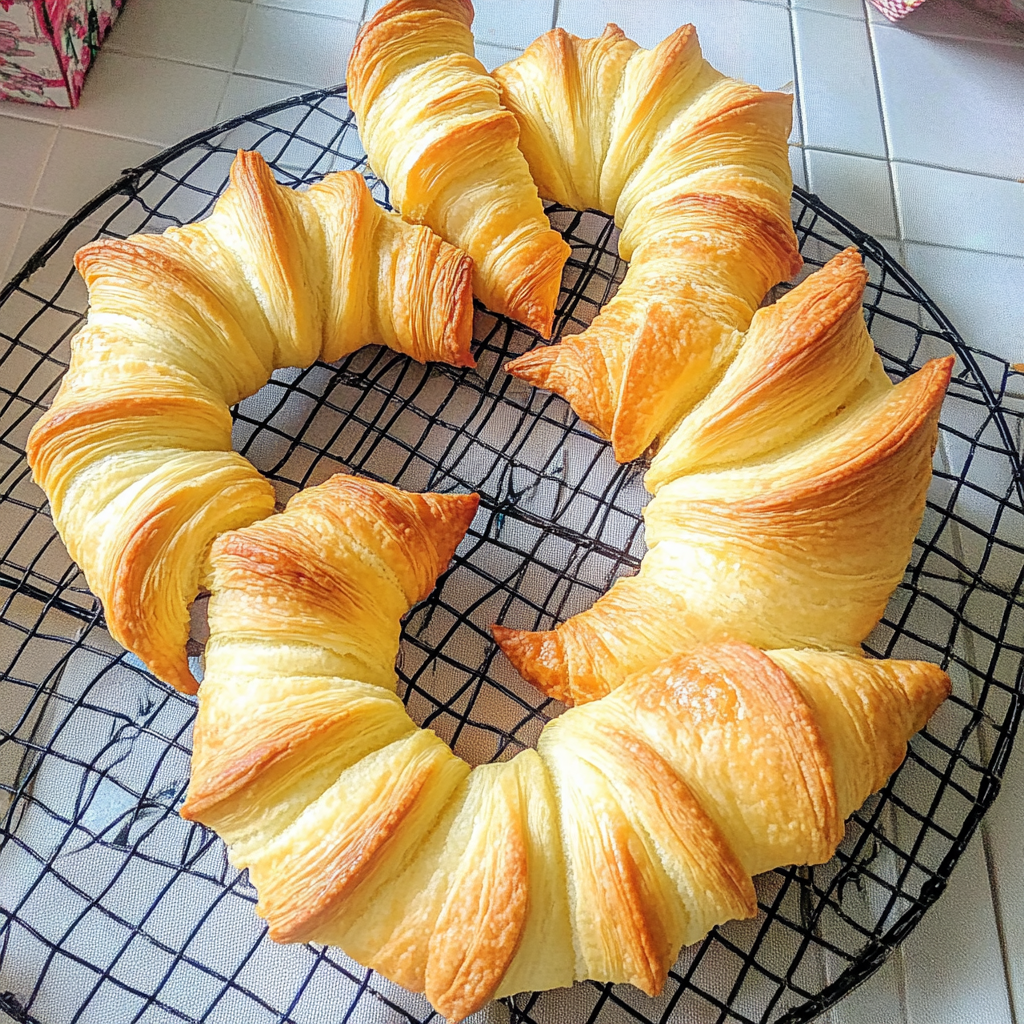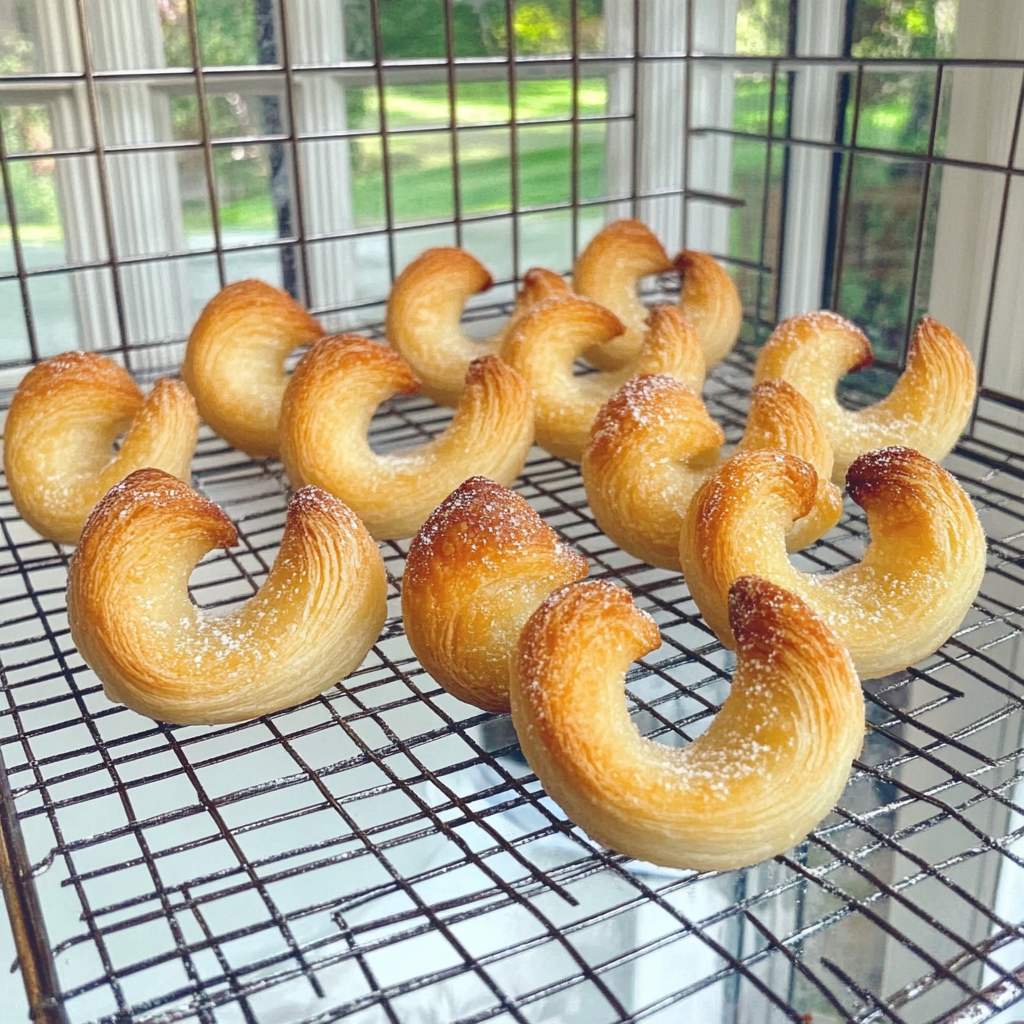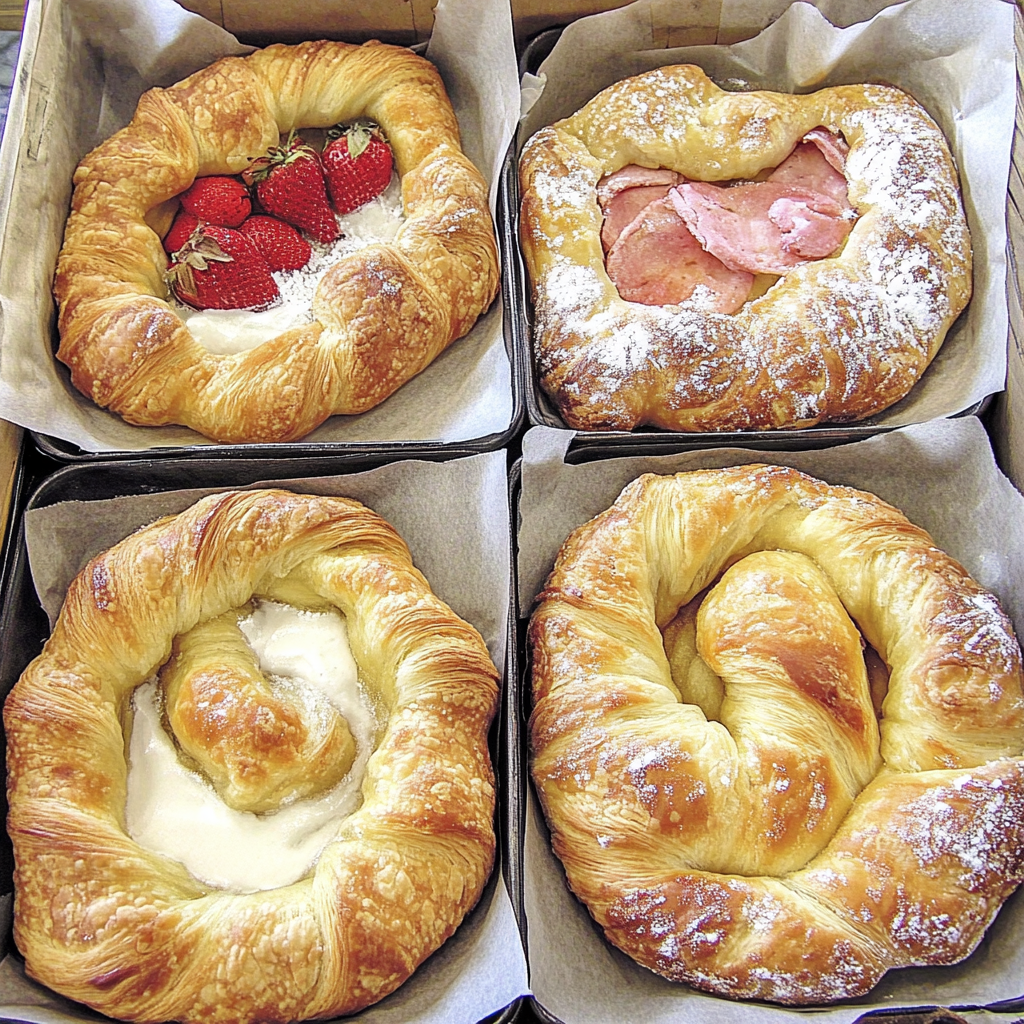🥐 Introduction to Gipfeli and Swiss Pastries
If you’ve never heard of Gipfeli, you’re in for a buttery surprise. These crescent-shaped pastries are Switzerland’s answer to the French croissant—only less greasy and often more versatile.
A Gipfeli is flaky, slightly dense, and made with laminated dough using less butter than traditional croissants.
They’re a beloved Swiss breakfast staple, served warm with coffee or filled with sweet or savory delights.
Now, if you’re already into baking treats like puff pastry desserts, transitioning to Gipfeli will feel familiar. These pastries don’t just look elegant—they’re easier to make at home than you think.
Even better, they offer a blank canvas for filling variations. Whether you love the fruitiness of jam or crave cheesy bites, Gipfeli delivers. Much like our easy 3-ingredient biscuit recipe, this dough rewards simplicity and patience. So, let’s roll up our sleeves and bring the flaky magic of Switzerland to your kitchen!
🧈 Core Ingredients for an Authentic Gipfeli Recipe
Creating the perfect Gipfeli starts with the right ingredients. Each component contributes to that light, flaky bite everyone loves.
All-purpose flour – Provides structure and elasticity for the dough.
Warm milk – Activates yeast and adds richness.
Instant yeast – Helps the dough rise for that airy texture.
Sugar – Adds a subtle sweetness without overpowering the pastry.
Salt – Balances the flavors and strengthens gluten.
Cold unsalted butter – Key to lamination and those crispy layers.
Egg – Brushed on top for a golden finish.
To see similar pantry-friendly recipes, check out this fluffy 3-ingredient biscuit guide. You’ll notice how simplicity shines when ingredients are fresh.
Also, if you’re exploring light dough-based options, don’t miss this classic Pastina recipe—a cozy dish that also starts with basic staples. So, gather these core items and let’s move on to optional fillings and tools next!

🍫 Optional Add-ins for Sweet and Savory Twists
Now that you’ve got your base dough ready, it’s time to customize your Gipfeli. Add flavors that suit your cravings.
Chocolate chips or chunks – Classic sweet surprise with every bite.
Fruit jam – Apricot or raspberry spreads bring a fruity burst.
Cheese – Swiss Gruyère or cheddar for a savory upgrade.
Herbs and ham – Create mini breakfast rolls or hearty snacks.
You’ll enjoy how versatile this pastry is. For example, our easy cinnamon crescent rolls show how even simple fillings can create magic.
Feeling adventurous? Try combining jam with cheese—similar to the bold fusion in this cherry delight dessert. It’s all about balance.
These optional add-ins turn your homemade Gipfeli into bakery-worthy creations without added complexity.
🧰 Essential Tools and Prep Tips for Perfect Gipfeli
To bake Gipfeli like a pro, you’ll need a few reliable tools. Keep your prep space clean and efficient.
Rolling pin – Essential for flattening laminated dough evenly.
Pastry brush – Applies egg wash for a glossy finish.
Baking sheet with parchment – Ensures no sticking or burning.
Sharp knife or dough cutter – Helps shape clean crescent triangles.
Before starting, prepare your space just like we recommend in the ultimate crumble cookie recipe. Organized tools save time.
Additionally, don’t forget to follow ingredient staging as you would in this coffee cookies recipe—it reduces stress while baking. With everything in place, you’re ready to roll and rise like a Swiss pastry chef.
👩🍳 Step-by-Step Recipe Process for Perfect Gipfeli
This simple method walks you through the entire Gipfeli baking process. Just follow each step carefully for flaky, golden results.
1. Prepare the Dough
Mix 3 cups flour, 2 tsp yeast, 2 tbsp sugar, and 1 tsp salt in a large bowl.
Add 1 cup of warm milk gradually. Stir until a soft dough forms.
Knead for 7 minutes by hand or use a mixer.
This stage is crucial, just like the dough prep in our easy biscuit recipe. A smooth dough gives better lamination.
2. Lamination with Cold Butter
Flatten ½ cup cold butter between parchment sheets.
Roll the dough into a rectangle. Place butter in the center.
Fold like a letter. Roll, fold again, and repeat this 3 more times.
Let the dough chill between folds if it warms. This prevents the butter from melting too soon.
3. Proof and Shape
Cover and let the dough rest for 90 minutes in a warm place.
Roll out the dough into a large rectangle, ¼ inch thick.
Slice into wide triangles. Roll each triangle from base to tip to form crescent shapes.
This shaping style is similar to what’s used in puff pastry dessert recipes—precision makes the difference.
4. Bake to Golden Perfection
Preheat oven to 375°F (190°C).
Place Gipfeli on a lined tray. Brush with a beaten egg.
Bake for 15–20 minutes until puffed and golden brown.
Let cool slightly and enjoy your homemade Swiss pastries warm!

🧁 The 7 Secrets to Making the Perfect Gipfeli
Want truly bakery-style Gipfeli? Master these essential secrets, and you’ll transform simple dough into flawless, flaky pastries.
1. Perfect Your Dough
Soft dough is the foundation. Knead until smooth and elastic.
Let it rest before laminating.
In recipes like this 3-ingredient biscuit guide, dough quality always matters.
2. Keep the Butter Cold
Use chilled unsalted butter during lamination.
If it softens, chill the dough again.
This step builds flaky layers—a must for professional texture.
3. Mind Your Temperature
Dough should stay between 68°F–72°F (20–22°C).
Too warm, and the butter melts.
Consistency in temperature is just as important as in the banana bread cake mix recipe.
4. Proof for Volume
Allow the dough to rise until doubled in size.
Avoid shortcuts—rushing ruins the texture.
5. Shape with Precision
Cut clean triangles. Roll from wide to narrow.
Curve the ends slightly for that signature look.
6. Egg Wash for Shine
Brush each pastry before baking.
This gives that irresistible golden color.
7. Bake at the Right Heat
Set your oven to 375°F (190°C).
Don’t overbake—watch closely in the last few minutes.
Flaky success happens when these steps align. Follow them like you would in a structured cookie recipe. You’ll never settle for store-bought again!
🧁 Creative Variations of the Gipfeli Recipe
Once you’ve nailed the classic version, it’s time to get creative. Gipfeli adapts well to both sweet and savory flavors.
🍫 Sweet Fillings
Add chocolate chips or chunks for a melty center.
Spread apricot jam inside before rolling for fruity depth.
Fill with almond paste for a nutty, elegant bite.
For more dessert inspiration, explore these puff pastry desserts that play with flaky layers and indulgent fillings.
🧀 Savory Twists
Try shredded Gruyère cheese with fresh thyme for a Swiss vibe.
Add ham and herbs to create satisfying brunch rolls.
Top with parmesan before baking for crisp, cheesy crusts.
This fusion of flavor mirrors techniques in recipes like our smoked queso—bold, creamy, and customizable.
🥦 Dietary Variants
Use vegan butter and almond milk for plant-based options.
Substitute gluten-free flour blends for sensitive diets.
With a few thoughtful tweaks, your Gipfeli can suit nearly every taste or occasion. Whether you’re planning breakfast or dessert, these variations keep your baking exciting and fresh.
❄️ Storing, Freezing, and Reheating Gipfeli
Freshly baked Gipfeli taste best warm, but smart storage lets you enjoy them later without losing quality.
🧊 Storage Tips
Keep Gipfeli in an airtight container at room temperature for 1–2 days.
For longer storage, freeze baked or unbaked versions in zip-lock bags.
You can freeze unbaked dough too, similar to how dough is managed in this easy 3-ingredient biscuit recipe.
🔥 How to Reheat
Preheat oven to 350°F (175°C).
Reheat frozen Gipfeli for 5–10 minutes until crispy.
Avoid microwaving—it makes them soggy.
This reheating process mirrors methods from recipes like our baked cottage cheese eggs, where oven heat keeps the texture right.
Proper storing and reheating mean your Gipfeli stay flaky and fresh—just like day one.

🥐 Gipfeli vs. Croissants: Key Differences
Though similar in shape, Gipfeli and croissants offer distinct textures, flavors, and cultural roots.
🔍 Key Differences:
Butter content: Croissants use more butter, giving them a richer flavor.
Texture: Gipfeli are firmer and slightly denser.
Flakiness: Croissants are lighter with crispier layers.
Origin: Gipfeli come from Switzerland, croissants from France.
Usage: Croissants are indulgent; Gipfeli are often simpler, eaten for everyday breakfast.
These differences are as noticeable as the textures found in puff pastry dessert recipes—light, layered, and golden.
While both use laminated dough, the end results differ. If you enjoy exploring unique pastries like the Swiss chocolate chalet cake, you’ll appreciate the subtle charm of Gipfeli.
Ultimately, Gipfeli provides a less greasy, more versatile option for casual or creative baking.
🛠️ Troubleshooting Guide: Fix Common Mistakes
Even with a solid recipe, your Gipfeli might not always turn out picture-perfect. Here’s how to correct the most common issues.
🌀 Why is My Gipfeli Dense?
Under-proofing is often the culprit.
Let dough rise fully until it doubles in size.
Use fresh yeast for better lift.
For more yeast-based insights, see how we manage proofing in our biscuit recipe.
🧈 My Pastries Are Greasy or Flat
Warm butter melts into the dough, ruining lamination.
Chill dough between folds to maintain layer integrity.
We use similar cooling techniques when crafting layered treats in puff pastry desserts.
🔥 My Gipfeli Baked Unevenly
Oven temperature matters—always preheat.
Bake at 375°F and avoid opening the oven mid-bake.
💡 Quick Fixes
If too flat, reduce butter slightly next time.
If too dry, shorten the baking time by 2–3 minutes.
With these fixes, your next batch of Gipfeli will bake up just right—light, flaky, and beautifully golden.
☕ Serving Suggestions for Freshly Baked Gipfeli
Gipfeli is best enjoyed warm and fresh from the oven. Pair it with classic sides or turn it into a mini meal.
Serve with coffee or hot chocolate for a cozy breakfast.
Add a dollop of fruit jam or a drizzle of honey for sweetness.
Slice and stuff with cheese or ham for a savory snack.
Include in brunch platters with baked eggs or fruit salad.
Like our baked cottage cheese eggs, Gipfeli adds warmth and texture to any spread. Whether sweet or savory, this pastry never disappoints.
❓ FAQs: Answering People Also Ask Queries
These answers help solve the most common questions about Gipfeli based on what people frequently search.
✅ What is the difference between a Gipfeli and a croissant?
Gipfeli has less butter and a firmer texture than a croissant. Croissants are fluffier and richer due to higher fat content.
🕒 Can you prepare Gipfeli dough ahead of time?
Yes! You can refrigerate the dough overnight or freeze it after shaping. Just allow extra proofing before baking.
🌡️ What temperature should Gipfeli dough be?
The dough should stay between 68°F and 72°F. Too cold, and it won’t rise. Too warm, and butter melts.
⚠️ What’s the most common mistake with Gipfeli?
Overworking the dough or letting butter soften too much ruins flakiness. Keep ingredients cold and follow each step carefully.
These answers ensure your next Gipfeli batch rises, bakes, and flakes just right. Want more help? Explore our easy baking tips for reliable results.

